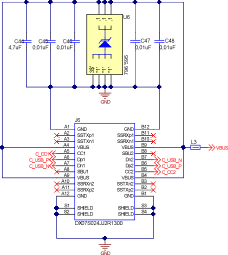TIDUEY1B November 2020 – April 2024 BQ25798
- 1
- Description
- Resources
- Features
- Applications
- 6
- 1System Description
- 2System Overview
- 3Hardware, Software, Testing Requirements, and Test Results
- 4Design and Documentation Support
- 5About the Author
- 6Revision History
2.4.5 USB Type-C® Receptacle
Figure 2-8 shows the schematic of the USB Type-C receptacle that this design uses. From this receptacle, the communication (CC1 and CC2) and VBUS pins are mapped appropriately to the TPS25750D PD controller. In addition, the TVS2200 diode, which is a 22-V precision surge protection clamp, was also added to the design at the USB Type-C port for added protection.
 Figure 2-8 USB Type-C®
Receptacle Circuit with TVS2200
Figure 2-8 USB Type-C®
Receptacle Circuit with TVS2200